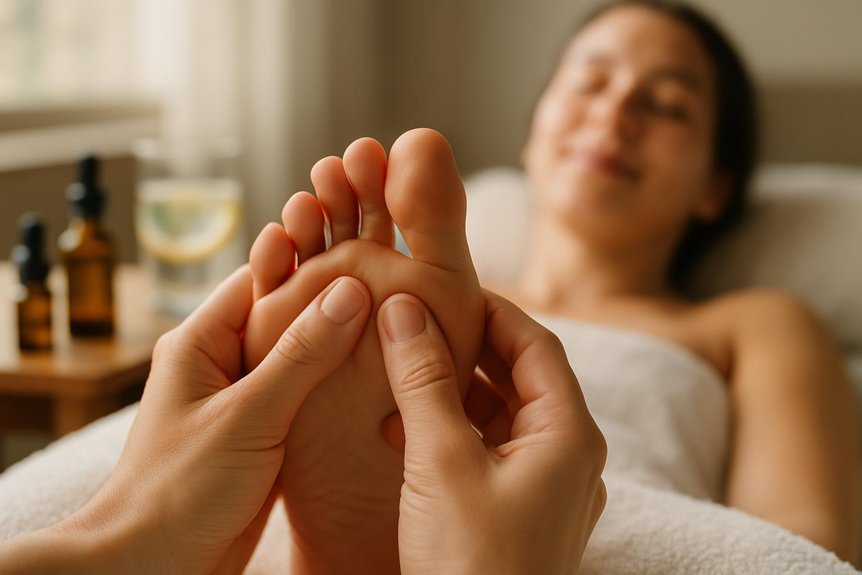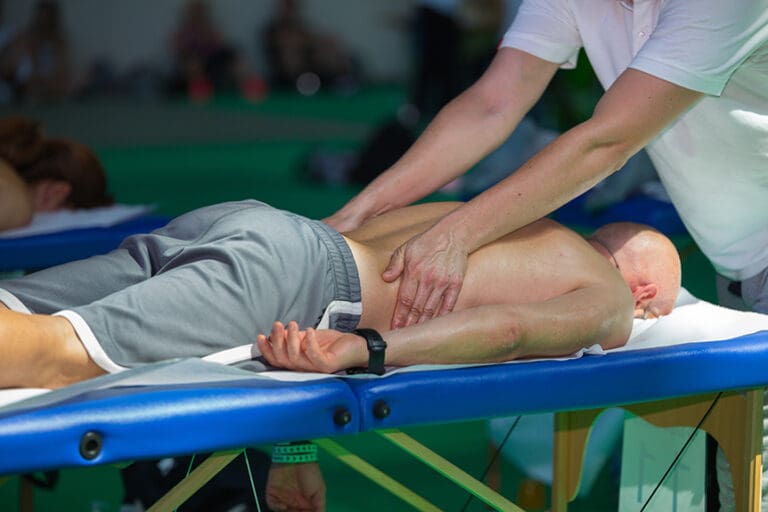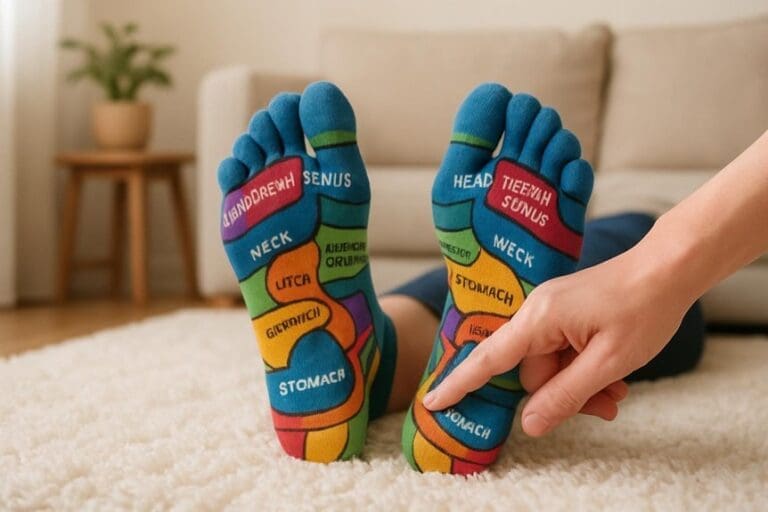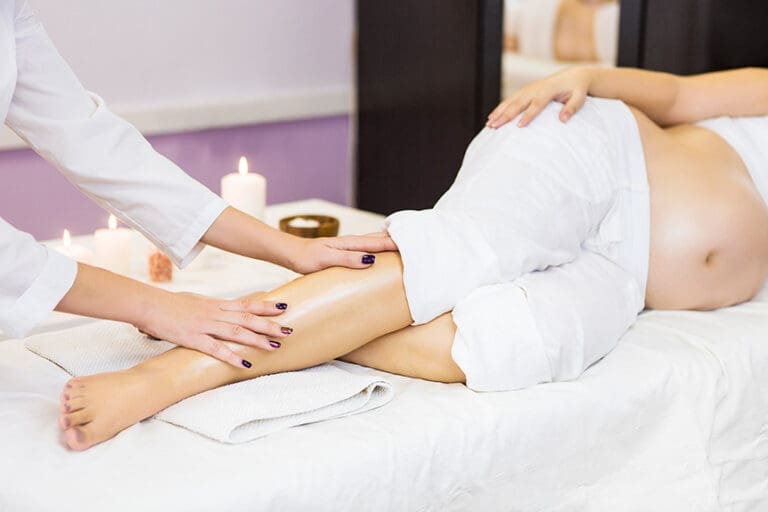It engages mapped reflex points on the feet, hands, or ears that correspond to sinus regions. Targeted stimulation of these areas can promote natural sinus drainage, potentially reducing congestion and improving breathing. Practitioners use gentle, evidence-informed techniques to enhance circulation and address underlying discomfort. While it does not cure medical sinus conditions, many clients experience symptomatic relief during and after sessions. Greater detail about the specific techniques, points involved, and overall benefits is provided further below.
Understanding Sinus Congestion and Its Causes

Why does sinus congestion occur, and what underlying mechanisms contribute to its onset? Sinus congestion typically arises when the delicate mucosal linings within the paranasal sinuses become inflamed or irritated.
This inflammatory response is often triggered by viral infections, allergens, or environmental irritants, leading to increased mucus production and swelling of the sinus tissues. The narrowed sinus passages impede normal airflow and drainage, resulting in a sensation of fullness, pressure, and discomfort.
In some individuals, anatomical variations or chronic underlying conditions may exacerbate these symptoms, making congestion more persistent.
At Spa & Massage, therapists recognize that sinus congestion can considerably impact daily wellbeing and relaxation. Addressing these concerns requires a nuanced understanding of each client’s health history, fostering a supportive environment to explore tailored wellness solutions.
Some individuals find relief from sinus congestion through therapies such as an aromatherapy massage, which can promote relaxation and may help ease discomfort.
What Is Reflexology and How Does It Work?
It is a therapeutic technique based on the principle that specific points on the feet, hands, and ears correspond to different organs and systems within the body.
Through precise mapping and targeted pressure to these reflex points, practitioners aim to stimulate natural healing processes and support physiological balance.
At Spa & Massage, this approach is integrated within a holistic wellness framework to address both localized symptoms and overall client well-being.
Principles Behind Reflex Therapy
How does targeted pressure on specific points of the feet influence overall well-being?
It operates on the principle that zones and reflex points on the feet correspond to organs and systems throughout the body. By applying controlled, methodical pressure to these areas, practitioners aim to stimulate neural pathways and promote physiological balance.
Clinical observations and client feedback at Spa & Massage suggest that this therapy may encourage relaxation, modulate stress responses, and support the body’s natural healing mechanisms.
This approach aligns with a holistic philosophy, acknowledging the interconnectedness of body and mind. In practice, Spa & Massage therapists tailor each session to individual needs, prioritizing comfort and trust.
Through sensitive touch, it aspires to foster a sense of grounding, intimacy, and enhanced overall well-being.
Reflex Points and Mapping
Although often perceived as a complementary therapy, the practice involves a structured method of applying pressure to specific reflex points mapped on the feet. It is based on the premise that designated areas on the feet correspond to organs, glands, and systems throughout the body.
For sinus relief, attention is given to the pads of the toes, where reflex points for the sinuses are located. Through precise stimulation of these mapped zones, therapists at Spa & Massage aim to influence neural pathways and support the body’s natural processes.
This method is rooted in client-centered care, ensuring tailored pressure and technique to maximise comfort and potential benefit.
Holistic Wellness Approach
When approached as part of a holistic wellness strategy, the practice involves systematic stimulation of specific reflex points on the feet, hands, or ears, each believed to correspond anatomically to organs and systems within the body.
It is grounded in the principle that targeted pressure can initiate physiological responses, supporting overall balance and encouraging self-healing.
Within Spa & Massage clinics, therapists integrate zone therapy with individualized care plans, considering each client’s unique health profile and wellness goals.
This approach aims to address not only localized issues, such as sinus congestion, but also broader stress-related factors and systemic imbalances.
The resulting experience is both restorative and tailored, fostering a sense of connection between physical wellbeing and emotional equilibrium, and supporting clients’ ongoing journey toward holistic health and resilience.
The Connection Between Zone Therapy and Sinus Relief

It targets specific sinus reflex points on the feet, hands, and face, which correspond to areas of sinus congestion and discomfort. Therapists at Spa & Massage apply precise pressure and specialized techniques to these points with the aim of promoting sinus drainage and improving comfort.
Many clients report reduced sinus pressure, clearer breathing, and an enhanced sense of wellbeing following these tailored zone therapy sessions.
Sinus Reflex Points Explained
A core principle of zone therapy is the belief that specific points on the feet, hands, and face correspond to organs and systems throughout the body, including the sinuses.
In the context of sinus relief, zone therapy practitioners identify precise reflex points—often located on the pads of the toes, along the fingers, and on the facial contours—that are anatomically linked to the sinus cavities.
Gentle yet specific stimulation of these areas is thought to encourage improved circulation, support lymphatic drainage, and modulate tension in the upper respiratory passages.
At Spa & Massage, therapists use evidence-informed mapping of sinus reflex points as part of a holistic approach, adapting pressure and technique to each client’s comfort.
This tailored methodology underscores a commitment to both effectiveness and client well-being.
Techniques for Sinus Relief
Building on the anatomical mapping of sinus reflex points, effective sinus relief relies on the application of targeted zone therapy techniques that stimulate these zones to influence sinus function.
Practitioners at Spa & Massage employ precise thumb and finger pressure, focusing on reflex areas along the toes and balls of the feet—zones corresponding to the sinuses in zone therapy charts.
Rhythmic, sustained pressure is delivered with sensitivity to client feedback, ensuring both comfort and ideal therapeutic effect. Techniques may include gentle circular motions and intermittent holds, designed to encourage lymphatic drainage and improve circulation in related sinus pathways.
At Spa & Massage, therapists tailor the session to individual sensitivity and sinus discomfort levels, fostering a sense of trust and personal attention that underpins the approach to holistic sinus relief.
Benefits Noticed by Clients
When clients receive targeted zone therapy at Spa & Massage, many report perceptible improvements in sinus-related symptoms, including reduced congestion, easier breathing, and diminished facial pressure.
Evidence suggests that precise stimulation of reflex points associated with the head and sinuses may promote lymphatic drainage and enhance local circulation, contributing to symptom relief.
Clients frequently describe a gentle release of sinus tension during and after sessions, often noting a sensation of openness across the nasal passages.
Therapists at Spa & Massage tailor each zone therapy treatment to individual needs, ensuring focused attention on areas most relevant to sinus health.
This approach aligns with a client-centered philosophy, fostering trust and comfort.
While individual experiences vary, the consistency of positive feedback underscores zone therapy potential as a supportive component in sinus management.
Key Reflex Points for Sinuses on the Feet and Hands
By understanding the specific locations of sinus reflex points on the feet and hands, zone therapy can be applied with targeted precision to support sinus relief.
Anatomically, sinus reflex points are mapped along the pads of the toes and fingertips, corresponding to the maxillary, frontal, and ethmoid sinus areas.
Gentle stimulation of these zones is believed to encourage improved circulation, facilitating natural drainage and reducing tension in sinus pathways.
At Spa & Massage, practitioners are trained to identify subtle variations in these reflex points, tailoring pressure and technique to each client’s unique needs.
This precise, individualized approach is designed to evoke a sense of comfort and direct attention to areas of congestion.
For those seeking relief, understanding these reflex points enhances the collaborative nature of the zone therapy experience.
How Our Therapists Apply Zone Therapy for Sinus Issues

Although sinus congestion presents with diverse symptoms, Spa & Massage therapists adopt a thorough approach to zone therapy that prioritizes client assessment and individualized care.
Each session begins with an extensive evaluation of the client’s sinus history, current discomfort, and any relevant health factors.
Therapists then select precise reflex points on the feet and hands, targeting areas corresponding to the sinuses, head, and lymphatic system.
Techniques such as gentle pressure, circular motions, and rhythmic movements are applied, calibrated to the client’s sensitivity and tolerance.
This method seeks to promote drainage, relieve facial pressure, and support the body’s natural healing mechanisms.
All interventions are guided by evidence-informed practice, ensuring the experience is both therapeutic and attuned to the client’s unique needs and comfort.
What to Expect During a Zone Therapy Session at Spa & Massage
Upon arrival at Spa & Massage, clients are welcomed into a calm, hygienic environment designed to facilitate relaxation and trust.
Each massage session begins with a confidential consultation, during which therapists assess individual health history, sinus symptoms, and wellness goals.
This client-centered approach allows for the design of a tailored treatment plan, focusing on the reflex zones correlating to sinus pathways.
Therapists utilize gentle, deliberate pressure techniques, often integrating warm towels for enhanced comfort.
Communication remains open throughout, with therapists adjusting techniques in response to client feedback.
The session is conducted in a private, softly lit room, promoting a sense of safety and intimacy.
After the session, clients receive aftercare guidance specific to maintaining relaxation and supporting ongoing sinus comfort at home.
Benefits of Zone Therapy for Sinus Congestion
Following the personalised approach established during each zone therapy session at Spa & Massage, clients often experience targeted relief from sinus congestion through precise stimulation of reflex points associated with the nasal passages and respiratory system.
This technique is informed by anatomical mapping, enabling therapists to address congestion by encouraging lymphatic drainage and improving local circulation. Many clients report a perceptible reduction in sinus pressure, enhanced ease of breathing, and a gentle sense of release following their sessions.
Zone therapy calming effects on the nervous system may also contribute to decreased inflammation and overall relaxation. This can amplify the sensation of comfort and wellbeing.
At Spa & Massage, therapists integrate client feedback and clinical intuition, ensuring that each treatment is responsive. This approach fosters an intimate sense of trust and ongoing relief from sinus discomfort.
At-Home Zone Therapy Tips for Sinus Pressure
For individuals seeking to manage sinus pressure between professional massage sessions, a structured approach to at-home techniques can provide adjunctive relief.
Evidence-informed self-care includes gentle stimulation of reflex points associated with the sinuses—typically located on the pads of the toes and the ball of the foot.
At Spa & Massage, therapists advise clients to apply consistent, moderate pressure in circular motions for 2-3 minutes per area, using a natural massage oil to enhance comfort and glide.
Maintaining a calm, mindful environment supports relaxation and optimises outcomes. Hydration and deep breathing are recommended before and after self-treatment to encourage sinus drainage.
These practices align with client-centered care, empowering individuals to engage actively in their wellness between appointments, while respecting personal boundaries and comfort.
When to Seek Professional Help for Persistent Sinus Problems
Persistent sinus symptoms—such as ongoing congestion, facial pain, or diminished sense of smell—may indicate underlying health concerns that extend beyond the scope of self-care or complementary therapies.
When these symptoms persist for several weeks, recur frequently, or are accompanied by fever or vision changes, prompt consultation with a healthcare professional is crucial.
Chronic sinus issues can be a sign of infection, structural abnormalities, or allergic responses requiring medical assessment and tailored intervention.
At Spa & Massage, therapists recognise their role in providing supportive care, not diagnosis.
Clients are always encouraged to disclose persistent or severe symptoms to their GP or relevant specialist.
Integrating professional medical advice ensures that therapies like this complement, rather than replace, essential clinical care for comprehensive sinus health.
Conclusion
In conclusion, zone therapy presents a promising, evidence-informed adjunct for managing sinus congestion by activating targeted reflex points correlated with sinus pathways. Like a gentle ripple effect, skilled touch may help stimulate the body’s natural clearing mechanisms—offering clients a non-pharmacological, client-centered approach for symptom relief. While not a substitute for medical care in persistent cases, zone therapy holistic focus aligns with the growing demand for integrative wellness solutions in sinus health management.



